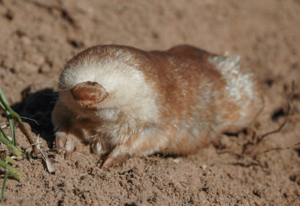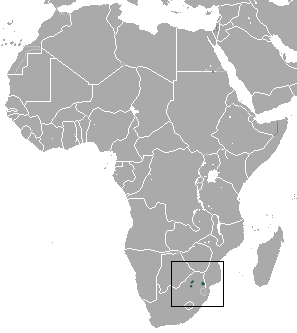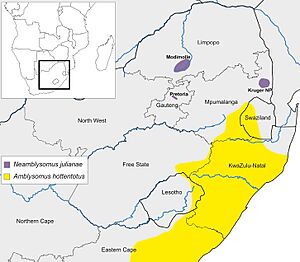Juliana's golden mole facts for kids
Quick facts for kids Juliana’s golden mole |
|
|---|---|
 |
|
| Conservation status | |
| Scientific classification | |
| Genus: |
Neamblysomus
|
| Species: |
julianae
|
 |
|
| Juliana's golden mole range | |
| Synonyms | |
|
Amblysomus julianae |
|
Juliana's golden mole (Neamblysomus julianae) is a unique golden mole that lives only in South Africa. It is listed as an endangered species, which means it is at high risk of disappearing forever. This is mainly because its home is being lost and it only lives in a few small areas.
Golden moles are an ancient group of mammals. This means they have been around for a very long time! They spend most of their lives living underground. The mole was named after Juliana Meester, who was the wife of the South African zoologist who discovered this species.
Contents
What Does Juliana's Golden Mole Look Like?
Juliana's golden moles have shiny, golden fur that is very thick. Their bodies are smooth and rounded, which helps them move easily underground. They don't have visible eyes or ears. Their small eyes are covered with hairy skin, so they are blind. Their tiny ears are hidden deep in their fur.
These moles usually weigh between 21 and 75 grams (about 0.7 to 2.6 ounces). This is about the weight of a small candy bar! Juliana's golden moles are generally smaller than other types of golden moles. They also have a less exaggerated middle ear bone compared to some of their relatives.
Juliana's golden moles are perfectly built for digging. They have strong, hard noses and large front claws that are great for digging through soil. Their webbed feet help them push dirt out of the way as they tunnel through the ground.
Where and How Do They Live?
Juliana's golden moles are solitary animals. This means they live alone, not in groups. They make their homes just below the surface of the ground. They prefer to live along rocky ridges made of quartzite or granite. You might also find them in well-watered gardens.
What Do They Eat?
Golden moles eat invertebrates. These are small creatures without backbones, like insects, earthworms, and snails. They usually hunt for food in the late afternoon and at night.
Life Cycle and Habits
Female Juliana's golden moles usually give birth to two young at a time, but sometimes only one. The babies are born in a special cavity underground that is lined with grass.
These moles dig their tunnels just under the ground's surface. During the morning and early afternoon, they often go into a state called torpor. This is like a short, deep sleep where their body temperature and activity slow down. It helps them save energy.
Juliana's golden moles need very specific places to live. They prefer areas with good tree cover and hard, sandy soil that drains water well. Because they are so picky about their homes, different groups of these moles can live very far apart. This makes it even more important to protect their habitats.
It is very hard to find Juliana's golden moles because they spend most of their time underground. Their tunnels are not easy to see, except for a few openings they create during the summer rainy season. Because they are so hard to find, scientists don't know much about them yet.
Why Are They Endangered?
Juliana's golden mole is found in a few places in South Africa. These include Pretoria (in Gauteng province), Nylstroom (in Limpopo province), and Kruger National Park (in Mpumalanga province). Even where they live, they are not found everywhere. Their populations are very spread out, sometimes hundreds of kilometers apart.
We don't have exact numbers for how many Juliana's golden moles there are. However, the population near Pretoria is in serious trouble. This area is seeing a lot of new buildings and mining, which is destroying their homes. This group is considered critically endangered.
The moles living near Nylsvley in Limpopo are on farmlands. These areas are changing due to farming, which can harm their habitat. Another big problem is habitat fragmentation. This means their homes are being broken up into smaller pieces. This makes it hard for moles to move around and find new mates, which can lead to inbreeding. Inbreeding can make a species weaker and increase its risk of extinction.
The International Union for Conservation of Nature (IUCN) has officially listed Juliana's golden mole as "endangered."
Conservation Efforts
Efforts to protect Juliana's golden mole are limited right now. This is mainly because we don't have enough information about them or their habitats. More studies are needed to understand these moles better.
Scientists are trying to monitor these moles when they can. There are also some educational programs to teach people about Juliana's golden mole and the threats it faces. Two out of the three known populations live in protected areas. However, more work is needed to protect their habitats to help this special mole survive.



